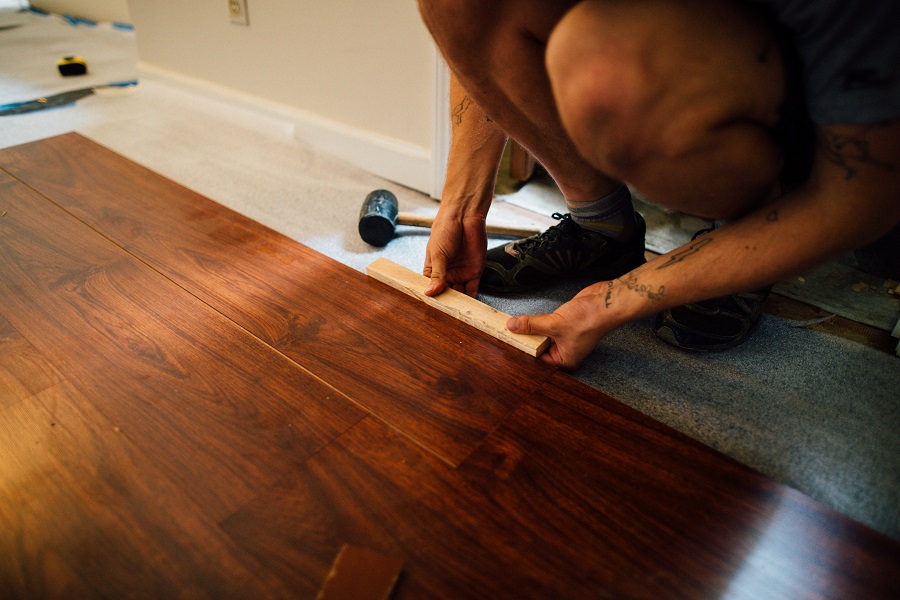
A Handy Person Can Install Laminate Flooring
Many people like to upgrade the appearance of their homes by installing laminate flooring. This is a project within the capability of handy homeowners. Follow this step by step procedure from the DIY Network online and you’ll have a nice looking new floor at a lower cost than hiring a contractor. Most homeowners can install between 150 and 300 square feet of flooring per day.
Getting Started
When installing laminate flooring, the first step is determining how much flooring you need. Measure the floor area you plan to cover and add then 10 percent to allow for waste. After buying the flooring, store it inside your house to acclimate it to room temperature. This will help prevent it from accumulating moisture as well as reducing expansion and contraction.
Remove the shoe molding from around the baseboard and any doors in the new floor area. The flooring planks will need additional clearance to fit under existing door frames. Place a piece of underlayment and laminate flooring next to the jamb to determine the appropriate height and cut out the desired area of the frame with a handsaw.
If your laminate floor is going directly over a concrete slab, apply a polyethylene plastic vapor barrier first. For all spaces, install floor underlayment. This comes in large rolls or as separate pieces that can be taped together. Make sure the edges don’t overlap. Tape the pieces together to prevent them from shifting. Create an expansion gap between the underlayment and the walls by using spacers. In addition to reducing noise, the underlayment cushions the laminate flooring so it is more comfortable to walk on.
Ready to Install

Check for damage on each plank before installing laminate flooring. Individual planks can be very hard to remove once they’re set in place.
Plan your installation so that the flooring helps emphasize the focal point of the room. Your beginning wall where you start installing the new floor should be more visible than your ending wall. Plan so that any flaws in the ending wall will be hidden by appliances or furniture.
The planks along the room edges should be at least 2″ wide. Check your measurements before you begin to make sure the planks along your ending wall won’t be too narrow.
Dry fit the first three rows of planks. If your beginning wall is uneven or has contours, you’ll need to trace a pattern to cut the laminate flooring to size. This will help keep the rest of the floor square. If your beginning wall isn’t parallel to your ending wall, that’s ok. You can make a few cuts to compensate. When you’re done, the irregularity probably won’t show.
When you’re ready to install the laminate, apply glue to the edges of each plank. Glue all the way along the long and short edges. Slide the plank into position and use a tapping block to make the joints as tight as possible. Don’t strike the tongue of the plank with the hammer, as you could damage it. Install the first three rows and then let them dry for an hour before you install the remaining planks. Stagger the joints within each run so that they are at least 8″ away from the joints of the preceding run.
When you get to the end of a run and need to make a cut, you may be able to use a scrap piece of flooring. If you have to cut an irregular angle, measure the short and long sides and the point at which the angle begins. Transfer the measurements to the back of the plank and use a saber saw to make the cuts.
Near the ends of the runs use a pry bar to tighten the joints. You can also use a strap clamp to hold the planks in place as the glue dries.
Install quarter-round shoe molding to cover the expansion gap around the edge of the flooring. The quarter-round will add a finished look to the floor and help hide irregularities. Measure each wall and cut each piece to length. Use a miter saw to make 45-degree cuts for inside and outside corners.
Nail the quarter-round into place, making sure you don’t nail through the laminate flooring. A pneumatic nailer will speed up the process.
If there’s another type of floor covering like carpet next to your new floor, use a reducer strip to make a visual transition between it and the laminate floor. Cut the metal mounting strip to the right length and secure it to the floor with screws. Then cut the reducer strip to length and snap it into the mounting strip. Now that you’ve finishing installing laminate flooring, sit back and enjoy the look of your new floor.
Ready to Install

Check for damage on each plank before installing laminate flooring. Individual planks can be very hard to remove once they’re set in place.
Plan your installation so that the flooring helps emphasize the focal point of the room. Your beginning wall where you start installing the new floor should be more visible than your ending wall. Plan so that any flaws in the ending wall will be hidden by appliances or furniture.
The planks along the room edges should be at least 2″ wide. Check your measurements before you begin to make sure the planks along your ending wall won’t be too narrow.
Dry fit the first three rows of planks. If your beginning wall is uneven or has contours, you’ll need to trace a pattern to cut the laminate flooring to size. This will help keep the rest of the floor square. If your beginning wall isn’t parallel to your ending wall, that’s ok. You can make a few cuts to compensate. When you’re done, the irregularity probably won’t show.
When you’re ready to install the laminate, apply glue to the edges of each plank. Glue all the way along the long and short edges. Slide the plank into position and use a tapping block to make the joints as tight as possible. Don’t strike the tongue of the plank with the hammer, as you could damage it. Install the first three rows and then let them dry for an hour before you install the remaining planks. Stagger the joints within each run so that they are at least 8″ away from the joints of the preceding run.
When you get to the end of a run and need to make a cut, you may be able to use a scrap piece of flooring. If you have to cut an irregular angle, measure the short and long sides and the point at which the angle begins. Transfer the measurements to the back of the plank and use a saber saw to make the cuts.
Near the ends of the runs use a pry bar to tighten the joints. You can also use a strap clamp to hold the planks in place as the glue dries.
Install quarter-round shoe molding to cover the expansion gap around the edge of the flooring. The quarter-round will add a finished look to the floor and help hide irregularities. Measure each wall and cut each piece to length. Use a miter saw to make 45-degree cuts for inside and outside corners.
Nail the quarter-round into place, making sure you don’t nail through the laminate flooring. A pneumatic nailer will speed up the process.
If there’s another type of floor covering like carpet next to your new floor, use a reducer strip to make a visual transition between it and the laminate floor. Cut the metal mounting strip to the right length and secure it to the floor with screws. Then cut the reducer strip to length and snap it into the mounting strip. Now that you’ve finishing installing laminate flooring, sit back and enjoy the look of your new floor.

